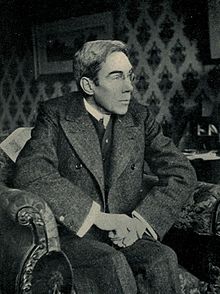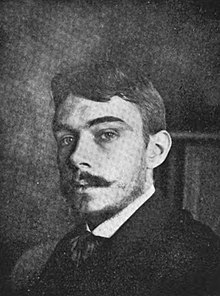| Henry Harland | |
|---|---|
 | |
| Born | March 1, 1861 Norwich, Connecticut |
| Died | December 20, 1905 (aged 44) Sanremo, Italy |
| Pen name | Sidney Luska |
| Occupation | Novelist, editor |
| Spouse | Aline Herminie Merriam |
| Signature | |
 | |
Henry Harland (March 1, 1861 – December 20, 1905) was an American novelist and editor.
Biography
Harland was born in Norwich, Connecticut, in 1861, the son of Fourierist Thomas Harland, who had been a one-time roommate of editor and author Edmund Clarence Stedman. He was raised in New York and, after the Civil War, the Harlands lived in a German Jewish section of the city.
Harland attended the City College of New York and briefly Harvard Divinity School. In May 1884, he married Aline Herminie Merriam, who shared his artistic interests. His literary career falls into two distinct sections. During the first of these, writing under the pseudonym Sidney Luska, he produced a series of highly sensational novels, written with little regard to literary quality. His novels written under this persona in the 1880s became the first popularly-read books to feature the American Jewish experience, which Harland both celebrated and criticized. Harland's depictions were met with wide criticism from the Jewish community. One review in the Philadelphia-based Jewish Exponent said one of his books was "grossly inartistic" and expressed "condescension" and "vulgar assumption towards Jews". Kaufmann Kohler in The Menorah complained that, in Harland's novels "the Jews, as a class, lack refinement".
But in 1889 Harland moved to London and fell under the influence of the Aesthetic movement. He began writing under his own name and, in 1894, became the founding editor of The Yellow Book. The short story collections of this new period, A Latin Quarter Courtship (1889), Mademoiselle Miss (1893), Grey Roses (1895), and Comedies and Errors (1898), were praised by critics but had little general popularity. He finally achieved a wide readership with The Cardinal's Snuff-box (1900), which was followed by The Lady Paramount (1901) and My Friend Prospero (1903). Hamlin Garland met him around this time and noted that he had affected a fake English accent. Garland recalled, "his 'extraoinary' English accent was comical. He spoke quite like the caricatured Englishman of our comedy stage. He is completely expatriated now and unpleasantly aggressive in his defense of England and English ways."

Harland's last novel, The Royal End (1909), was incomplete when he died. His wife finished it according to his notes. He died in 1905 at Sanremo, Italy, after a prolonged period of tuberculosis.
After his death, Henry James wrote positively about both Harland and The Yellow Book, though he had previously disparaged both.
Works
- As It Was Written: A Jewish Musician's Story (1885)
- Mrs Peixada (1886)
- My Uncle Florimond (1888)
- Grandison Mather (1889)
- Mademoiselle Miss, and Other Stories (1889)
- Two Women or One? From the Mss. of Dr. Leonard Benary (1890)
- The Yellow Book, An Illustrated Quarterly. Vol. 1, April 1894
- The Yellow Book, An Illustrated Quarterly, Vol. 2, July 1894
- Grey Roses (1895)
- The Yoke Of The Thorah (1896)
- Comedies and Errors (1898)
- The Cardinal's Snuff-Box (1900)
- The Lady Paramount (1902)
- My Friend Prospero (1903)
- The Royal End: A Romance (1909)
References
- Harland, Henry in Who's Who in America (1901-1902 edition); via archive.org
- Henry Harland, an American Forerunner of Proust, by Justin O'Brien; in Modern Language Notes; Vol. 54, No. 6 (Jun., 1939), pp. 420-428
- ^ Harap, Louis. The Image of the Jew in American Literature: From Early Republic to Mass Immigration (Second Edition). Syracuse, NY: Syracuse University Press, 2003: 455. ISBN 0-8156-2991-5
- Barbara Schmidt (2012). "Henry Harland (1861–1905) Archived 2018-06-02 at the Wayback Machine. The Yellow Nineties Online
- ^ Harap, Louis. The Image of the Jew in American Literature: From Early Republic to Mass Immigration (Second Edition). Syracuse, NY: Syracuse University Press, 2003: 465. ISBN 0-8156-2991-5
- Harap, Louis. The Image of the Jew in American Literature: From Early Republic to Mass Immigration (Second Edition). Syracuse, NY: Syracuse University Press, 2003: 566. ISBN 0-8156-2991-5
- Regina Randolph Jenkins (1914). "Henry Harland". The Catholic Encyclopedia, Vol. 16 (Index). New York: The Encyclopedia Press
- Parry, Albert. Garrets and Pretenders: Bohemian Life in America from Poe to Kerouac. Mineola, New York: Dover Publications, Inc., 2013 (originally published 1833): 127. ISBN 978-0-486-48605-5
Notes
- Harland often claimed to have been born in Saint Petersburg, which is reflected in multiple contemporary reference works such as Who's Who in America, but later scholars have discounted this.
- The Oxford Companion to American Literature. 6th Edition. Edited by James D. Hart, revised by Phillip W. Leininger. New York & Oxford: Oxford University Press, 1996. p. 271. ISBN 0-19-506548-4.
 This article incorporates text from a publication now in the public domain: Cousin, John William (1910). A Short Biographical Dictionary of English Literature. London: J. M. Dent & Sons – via Wikisource.
This article incorporates text from a publication now in the public domain: Cousin, John William (1910). A Short Biographical Dictionary of English Literature. London: J. M. Dent & Sons – via Wikisource.- Foote, Stephanie. "Ethnic Plotting: Henry Harland and the Jewish Writer." American Literature. March 2003 (75:1): 119–140.
External links
- Works by Henry Harland at Project Gutenberg
- Works by or about Henry Harland at the Internet Archive
- Works by Henry Harland at LibriVox (public domain audiobooks)

- "The Story of America’s Non-Jewish, First ‘Jewish Novelist’" by Harold Brackman, The Algemeiner, May 5, 2021
- Article from March 1895 edition of The Bookman (New York) on Henry Harland and The Yellow Book
- 1861 births
- 1905 deaths
- 19th-century American novelists
- 20th-century American novelists
- American magazine editors
- American male novelists
- Converts to Roman Catholicism
- Writers from Brooklyn
- Novelists from New York City
- 19th-century American male writers
- 20th-century American male writers
- 20th-century American non-fiction writers
- American male non-fiction writers